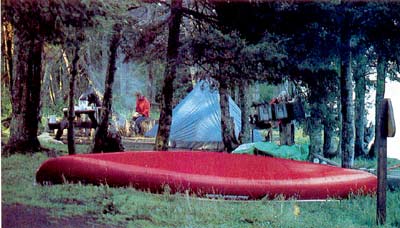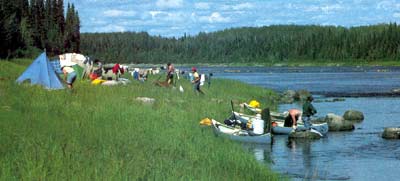| Exploring on daytrips is fun,
but eventually you will want to try an overnight stay. Camper
cruising or small-boat camping will add an interesting new dimension
to your use of any small powerboat, rowing craft, sailboat, canoe,
or kayak. The amount of enjoyment you get depends on the equipment
you choose. Clothing that won't keep you warm and dry and a tent
that allows water or bugs in will make that first experience memorable
in the worst way.
You need to think like a backpacker, getting
the maximum use from a minimum of equipment. Consider every item.
Don't continue bringing gear you don't use. If you are fairly
ruthless with your decisions, you will have a light load. While
the constraints of excessive weight don't affect the boater as
much as the backpacker, thinking light is important because the
extra load can affect how your craft handles. The gear should
also pack into a small area, a critical factor in the cramped
confines of some boats.
Clothing Choices
The best place to start looking at equipment
is in a backpacking or canoe camping specialty shop. Specialty
shops give choices in prices and weight and sell quality gear.
They may also rent equipment.
You will be living in a wet environment, and
your gear must deal effectively with moisture from internal and
external sources. Proper clothing can make the difference. Wool
and cotton are still useful, but there are limitations to their
comfort. Wool holds 40 percent of its weight in water, and cotton
200 percent. If you have ever worn a rain-soaked sweater, you
understand what that means. But there are some great new materials
available designed to function in damp conditions, not absorb
as much water, and release it easier.
Layering is a buzz word in the high fashion
industry these days. But it has application to all outdoor sports.
The technique allows you to regulate your temperature as you warm
up or Good campsites are easy to find on Maine's Allagash Wilderness
Waterway. cool down by taking off or adding a layer. Fast-drying
nylon shorts and a cotton shirt are fine if the weather is good,
but add some wind from a wet crossing or a little rain and your
enjoyment will depend on how well you choose your outfit.

On an Allagash trip, canoes were sailed
60 miles
downriver in two days - without the need for paddling.
A layer of light, water transporting, stay-dry
material keeps you feeling comfortable. Polypropylene, used to
line disposable baby diapers, was the first miracle fabric designed
to move water or sweat. Serious cross-country skiers found polypropylene
long underwear perfect under racing suits because of its unique
self-drying quality.
There have been several new materials developed
that function in the same way as polypropylene. Capilene from
Patagonia, Thermax from Dupont, and FRP from Odolo all work well.
Long and short sleeve shirts and pants are
available in different weights. The lightest and thinnest is appropriate
for strenuous activity, rowing or paddling, in all but the worst
weather conditions. The medium and heavy weight cloth will work
for sailing or sitting in camp. Try a set of the light weight
and add the other after you discover what works in your situation.
Other new fabrics have come along to remove
the difficult task of trying to dry a wet wool shirt or sweater.
Pile in polyester, nylon, and polypropylene absorbs 15 percent
or less of its weight in water. First used by North Sea fishermen
in conditions similar to our worst, pile proved tough, warm, and
quick drying. It comes in full-zip jackets, good for ventilation,
or pullovers that are a little less expensive. If pile does get
wet it can be wrung out or shaken out and worn.
For most of us, any area where there is good
boating has rain—sometimes for days. You can choose waterproof
or waterproof and breathable rain gear to cover your insulation
layers. A jacket and pants are ideal. A poncho blowing in the
wind has no place in any small craft. Suits are available with
bib pants providing double protection through the middle of your
body.
The waterproof breathable fabrics, Gore-Tex,
Entrant, Bion II, and others, have a disadvantage. When contaminated
by salt water and dirt, they are rendered ineffective as raingear.
Your choice of fabrics will depend on how you boat. If you will
be sitting in a sailboat, you won't require the breathability.
If you are rowing or paddling, you will be sweating and the breathability
is nice, allowing your sweat to pass through.
There are a number of coatings used to waterproof
raingear. The most common is polyurethane. It is inexpensive,
a good choice except for one drawback. If it is stored wet, it
will soon peel off, leaving you with a cloth jacket that can't
deflect a heavy dew. Longer lasting coatings include neoprene,
acrylic nitrile and or poly vinyl choride (PVC). They won't peel
but are more expensive and heavier.
Consider a wet or dry suit if you are boating
in bad conditions. Try renting a suit from a local boardsailing
shop before you buy.

Wilderness campsite on the Allagash shelters
boaters after a day on the river
Loose-fitting rubber boots that come just below
the knee will easily slip off if you are forced to swim and get
you ashore or afloat without getting your feet wet. In our ocean
kayaks, we wear boots with neoprene wet suit booties underneath.
The rubber boots ride behind the seat
where we can slip them over the booties when coming ashore. In
benign conditions, an old pair of running shoes or boat shoes
are good. But don't try scrambling around the rocks in wet leather
boat shoes. Wool or polypro socks are best for wear under boots
and shoes.
A sou'wester-style fisherman's cap will keep
the water off and allow your head to turn without restriction.
A wool or polypro watch cap, for warmth, can be worn. underneath
or by itself. Sunny days and hot weather require a visor or broad
brimmed hat.

You need to think like
a
backpacker, getting
the maximum use from a
minimum of equipment.

Finding the right outfit is a personal,
regional, and seasonal problem. Experiment to find out what works
in your area, but remember, it is always better to be over than
under prepared.
Camp Gear
Tents come in a number of styles, but
only two should be considered seriously, the dome and the outside
frame type. You will often camp on sandy or rocky ground where
putting in tent stakes is impossible. The outside frame or dome
can be set up anywhere without stakes. They do have one drawback:
An unstaked freestanding tent will blow away. Weight it down with
gear, keep a hand on it, or tether it to a rock or tree.
The tent body should be made of breathable
fabric, usually nylon, with a waterproof rainfly. A totally waterproof
tent keeps condensation inside and will soak your gear.
Good tents have quality bug netting, usually
listed as midge proof, and zippers that will stand the strain
of constant use. A tent designed for three or four people is perfect
for two in rainy country. In bad weather, you will be spending
a lot of time inside, and having a little extra room is nice.
Use a ground cover or plastic sheet to protect the bottom from
rocks and roots you can't remove from the site.
A tarp is very handy to cook under. It
will give you a dry place out of the tent to sit during a shower
or storm and store some gear that would otherwise be in the tent.
Sleeping bags should be filled with one
of the artificial products—Hollofill II, Quallo-Fill or
Polarguard. Down, the old standard, absorbs water, provides no
warmth when wet, and is impossible to dry outside. The artificial
fills can be wrung out.
A mummy-style or tapered bag shape is
warm but constrictive. A rectangular bag rated to 30 or 40 degrees
will work well for most conditions, and we always include a sheet
to use when it's warm.
While the bag may feel thick and comfortable,
you will need to put a pad underneath to keep from feeling rough
terrain. There is also dampness that works through the tent floor
that should be kept out of the bag. Closed cell foam is too thin
and open cell pads absorb water. But if you take care of the open
cell pads, storing them in a dry bag, they work well.

Good campsites are easy to find on Maine's
Allagash Wilderness Waterway
Cooking gear should include several pots
of different sizes. Also, you can add a small frying pan, cups,
plates and silverware. For work around the fire and cleanup, include
pot grips or pliers, a hot mitt, soap,
and a scrubby.
While beach-side campfires are nice,
conservation and regulation often prohibit their use. A good stove
is a must for damp conditions, allowing you to cook anywhere.
A white gas stove with a pressure pump is perfect for shoreside
cooking, but should never be used in a boat. I have had three
stoves flare uncontrollably in lakeshore campsites. If any of
those occurrences had happened in a boat, there is no way they
could have been stopped.
Sailors will recognize the use of alcohol
as an on-board fuel. In Europe, where it is difficult to get quality
white gas, alcohol is also used as a camping fuel. There are lightweight
cooking kits available with alcohol burners that work very well.
Bottled gas (butane or propane) stoves also work well in all but
the coldest conditions.
Packing
It should be possible to put all your
gear and food for two weeks, including your tent and sleeping
bag, into one or two waterproof packs or containers. Army surplus
ammo boxes and even Tupperware containers are fine, but you will
find bags are easier to pack. They come in all sizes. Try to match
the size of your storage areas with the bags. A pair of large
narrow bags that fit nicely on both sides of a centerboard trunk
would be of little use to a sea kayaker who must stuff all of
his gear through two small hatches.
Materials vary from double-reinforced
plastic bags to rubberized cloth-backed types. We have used the
sliding closure bars and tobacco roll tops with success.
For safety, put everything in Ziploc
bags. Our waterproof gear bags ride in soft packs or duffles for
additional protection. Since you must attach the bag to your boat,
the pack straps make that easier. Even if the weather is perfect,
plan on getting wet and you will never deal with wet gear.
Start with overnight trips and develop
your techniques. Make lists of everything that works and discard
the rest. A few overnight trips may be the incentive you need
to try a long wilderness adventure.
***
STAN WASS is an experienced outdoorsman
based in West Suffield, Connecticut.

|



